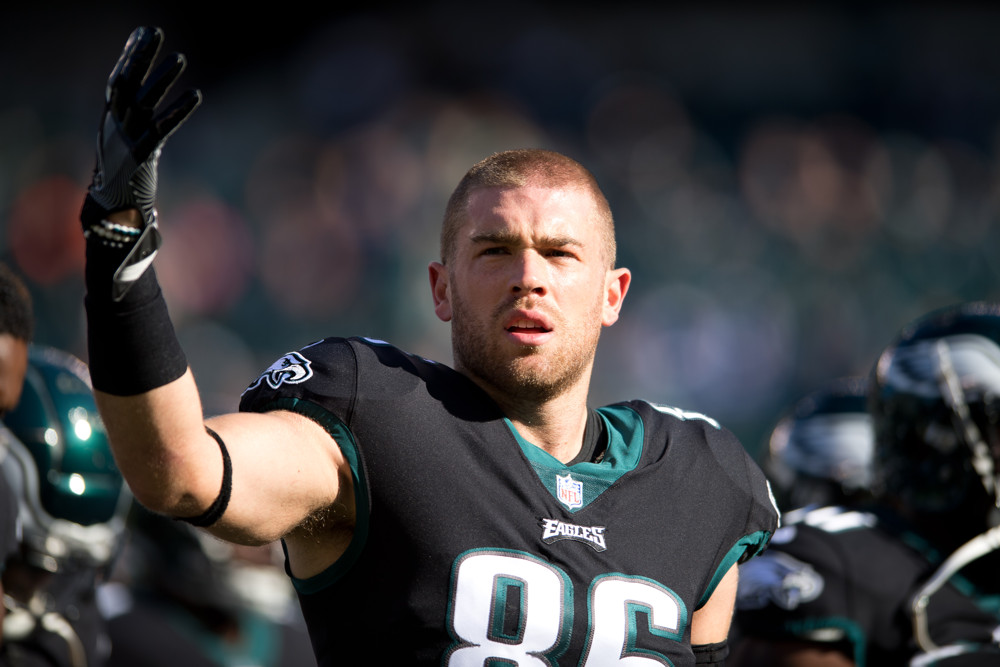Last Updated: August 27th at 2:59pm ET.
1. Rams RB Todd Gurley – You probably know this story by now. Gurley tore his left ACL at Georgia late in 2014, yet still entered the 2015 draft. Per The Athletic’s Mike Lombardi – then part of the New England Patriots’ staff – NFL teams were surprised the Rams drafted Gurley tenth overall because his knee was flagged as potentially arthritic. And they were especially surprised when the Rams gave Gurley a four-year, $57.5 million extension with two years left on his rookie deal. Gurley missed the final two games with knee inflammation last regular season, and Lombardi reported Gurley could barely walk around team headquarters. He was limited throughout the playoffs, and the Rams immediately showed their concern by matching backup Malcolm Brown’s two-year, $3.3 million offer sheet from Detroit, then trading up to draft Darrell Henderson 70th overall. In June, Gurley’s trainer Travelle Gaines confirmed the running back is dealing with “an arthritic component to his knee,” putting Gurley at risk of future setbacks and in need of every-week management. Gurley will likely struggle to practice regularly and stay in optimal shape.
2. Raiders WR Antonio Brown – Brown’s target projection remains among the league’s elite, but he is at risk of severe efficiency loss downgrading from Ben Roethlisberger to Derek Carr. And Brown quietly showed signs of decline last year, his fantasy output carried by a league- and career-high 15 touchdown catches that are sure to regress. Brown’s 1.94 yards per route run and 7.7 yards per target were both his fewest since 2012, and his 61.9% catch rate was Brown’s lowest since 2011. Whereas last year’s Steelers ranked first in the NFL in pass attempts and fifth in offensive plays, Jon Gruden’s Raiders were 16th and 24th, respectively. And there is risk Brown’s vertical skills will be squandered by Carr, whose percentage of 20-plus-yard downfield attempts ranked 32nd, 15th, 26th, and 20th over the past four years. Big Ben finished 10th, 1st, 4th, and 4th in those same seasons. Changing teams in his age-31 campaign and an increasingly combustible personality, Brown is a season-long fade anywhere inside the top-three rounds. It doesn’t help that Brown missed all but 30 minutes of training camp due to foot infections and an odd-ball dispute with the NFL over his helmet.
3. Vikings WR Adam Thielen – Thielen isn’t quite set up to bust, but his second-round cost is lofty for a volume-driven slot receiver on an increasingly run-committed team. Albeit in an admittedly tiny late-season sample, Thielen’s per-game targets dove from 10.8 under pass-happy OC John DeFilippo to 4.0 with interim OC Kevin Stefanski, and new offensive boss Gary Kubiak was handpicked by Mike Zimmer to keep establishing the run. Thielen is much more of a WR2 floor than WR1 ceiling pick this season. The Vikings’ defensive personnel remains strong enough to keep the offense in run-friendly game scripts.
4. Eagles TE Zach Ertz – Even as he is entrenched as a top-three fantasy tight end, I keep moving Ertz down my Top 150 as a player I’m letting others draft. A big concern is the depth of Philly’s skill-position corps, which returns Alshon Jeffery and Nelson Agholor and added DeSean Jackson, J.J. Arcega-Whiteside, Jordan Howard, and Miles Sanders. Dallas Goedert is primed for a bigger role, and the Eagles’ defense looks much stronger on paper after a crippling rash of 2018 injuries. Their pass-attempt volume is likely to dip. Ertz’s 2018 target total was 44 higher than his prior career high, and his catches were 38 more than Ertz’s previous personal best, putting him at major regression risk. Ertz remains worthy of third- to fourth-round consideration in season-long leagues, but Travis Kelce and George Kittle are clearly ahead.
5. Redskins RB Derrius Guice – Guice tore his ACL last preseason, missed his entire rookie year, required three additional surgeries due to an infection in the knee, and was reported to be coming along “slower than expected” by Adam Schefter after the draft. Guice also dealt with a hamstring injury leading into training camp. The Redskins enlisted insurance policies by re-signing Adrian Peterson and drafting Bryce Love, while Chris Thompson returns as Washington’s passing-game back. On a bad Redskins team that will likely play frequently from behind, Thompson is the favorite to lead Washington’s backfield in snaps, while Guice shares early-down work with Peterson. As an early-down committee member on a bad team, Guice’s ADP is one of the most egregious in all of fantasy.
6. Colts TE Eric Ebron – Ebron is one of 2019’s easiest fantasy football fades, and not just because the Colts added Devin Funchess and Parris Campbell to siphon targets in the middle of the field. When both Colts tight ends were healthy in six 2018 games, Jack Doyle out-snapped Ebron by a 167-play margin and out-targeted him 5.5 to 3.7 per game. Ebron’s career-high 14 touchdowns are wildly unsustainable after he went his previous seven football-playing seasons without topping five touchdowns in an individual year. Andrew Luck‘s stunning late-August retirement should have locked Ebron into do-not-draft lists.
7. Saints QB Drew Brees – Brees has just barely finished as top-ten QB1 in back-to-back years after ranking top six or better in eleven straight seasons prior. That’s despite Brees leading the NFL in completion rate in both years. As New Orleans’ defense and run game have improved, Brees has been more caretaker than centerpiece on the balanced Saints. Brees is also due for touchdown-rate regression after logging a 6.5% clip in 2018, 1.2% higher than his career average. Now 40 1/2 years old, perhaps most concerning was Brees’ 2018 late-season swoon. He went from averaging 285.0 yards with a 29:2 TD-to-INT ratio in his initial 11 starts to 234.5 yards with seven touchdowns and five picks over the final six, including playoffs.
8. Giants WR Golden Tate – Tate’s 2019 prospects are littered with red flags as an over-30 receiver coming off a career-worst year on his third team in two seasons joining a Giants club destined for quarterback transition. In New York, Tate will compete for Eli Manning and eventually Daniel Jones’ targets with Sterling Shepard – a player with whose skill set Tate is redundant – as well as Saquon Barkley and Evan Engram, all of whom have established rapports with Eli and operate in similar quadrants of the field. Tate’s four-game PEDs suspension further reinforces the fact that he’s a player to almost completely avoid regardless of format.
9. Broncos WR Emmanuel Sanders – Sanders enters his age-32 campaign coming off a Week 14 Achilles’ tear entering a newfangled Rich Scangarello-coordinated offense where Courtland Sutton and DaeSean Hamilton are the future of Denver’s wideout corps. With Vic Fangio overseeing one of the NFL’s most-talented defenses and sharply-declining Joe Flacco entrenched at quarterback, the Broncos already offer a probable low-volume passing offense that will also struggle for efficiency. Sanders is a player to scratch off season-long cheatsheets.
10. Falcons RB Ito Smith — Smith has generated an irresponsible amount of sleeper hype relative to his prospect profile and production. A fourth-round pick in the 2018 draft, Smith tested as a definitively-average athlete coming out of Southern Miss, where he starred against weak Conference-USA competition. Neither Smith’s yards per carry (3.5) nor his yards per catch (5.6) were rookie-year positives with Atlanta, and Steve Sarkisian‘s offensive staff under which Smith earned more playing time than expected was replaced by Dirk Koetter. Ultimately, Smith is likely best approached as a replacement-level talent in danger of losing Falcons No. 2 back duties to bigger, faster, and higher-ceiling prospects Brian Hill and Qadree Ollison.



